Phantom Limb Research Results
(updated
01/03/10 --» What’s new?
)
Contents
This page the results of our
phantom limb research to date.
- Physiological
condition of M.G.’s left hand adactylia (2007)
- Locating and
mapping phantom finger “ends” through right finger
“touching” (2007)
- Preliminary
tests of M.G.’s sensations when “touched”
by an object (2007)
- Preliminary
tests of
M.G.’s interactions with different areas of another
subject’s
face (2007)
- Tests of
M.G.’s interactions with different points on the back of the
head (2007)
- Tests of
M.G.’s interactions with a different subject (2007)
- Comparison of interactions
with S.M. on the same points, 2007 versus 2009
- Different
subjects also reported complex visual experiences (2009)
- Subjects had a
wide range of sensations and physical reactions (2009)
- Preliminary
blinded trials of randomized “touch” and
“no touch” cases (2009)
- M.G.’s
own sensations and physical reactions during the tests (2009)
- Tests of
possible physical interactions with M.G.’s phantom fingers
(2009)
- Access
to detailed research results
PLEASE
NOTE:
The
videos and photographs on this page are copyrighted and are presented
here to assist
other researchers to analyze our research and provide comments. The
videos and photographs are not to be copied, saved or republished
without express written permission of the authors.
Comments on our work are welcome!
Please feel free to comment on our Discussion Group on the Self-Conscious Mind. More
extensive, detailed experimental results are
available to people with a legitimate research
interest. See
below for access details
Robert
and Suzanne Mays
What’s
new?
- 01/03/10 - added link to access to
detailed research results
- 09/27/09 - clarified
subject's reaction to “touch” with
dizziness and headache, based on subsequent interview with subject
- 09/09/09 - reorganized page; split
off and summarized results from detailed 2007 page; added
summary research results from 2009 sessions
1.
Physiological
condition of M.G.’s left hand adactylia (2007)
2.
Locating and mapping phantom finger “ends” through
right finger “touching” (2007)
2007:
M.G. “finding” her fingers - first procedure:
With eyes closed
or looking
away, M.G. went through the
process of feeling where the “ends” of her phantom
fingers are, by
pulsing them with the tips of the right-hand fingers. The
“ends” appear
to be somewhat farther out than where her fingers would normally be.
M.G. can feel something more subtle even further out than the
“ends” of
her phantoms. Her right finger tips feel a warmth and resistance at the
point of “contact” with the
“end” of the phantom finger. Physical
sensations are felt when activating the finger
“end”: (1) a tingling in
the corresponding finger bud, (2) a warmth and pressure in the left
palm, and (3) a sensation on the outside surface of the arm going up
the forearm to a specific spot in the outer upper arm. These latter
rising sensations can sometimes go up into the left jaw and head. The
left arm sensation is somewhat masked when the left arm muscles are
holding the arm up, as opposed to having the arm rest on something.
After the exercise there was a residual warmth and an increased
circulation in the finger buds.
|
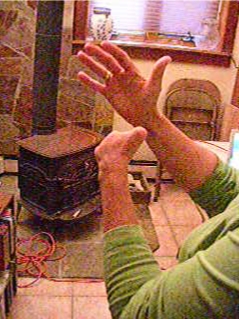
Streaming video
(11.4 MB, 6’08) |
| 2007: M.G.
“finding” her
fingers - second procedure: M.G. usually
feels a streaming sensation of her phantom fingers where there
are
two points, a weaker point, about a foot away from the
“end”, where
there is the first sensation of the finger, then a stronger point much
closer where the finger “end” is felt, where there
is a firmer
sensation both in the right finger and in the finger bud. From the
questionnaire M.G. had filled out (Q12): “The
right fingers kind of make “ends” on the phantoms.
Usually
I feel [the phantoms as] a streaming
out [and] the right hand touches where the tips of the fingers would
be. The feeling
actually starts further out – that’s what I mean by
[my
left hand, for as long as I can remember, always felt]
“big” – but closer in
it’s
heavier, thicker. There’s a dense place, about where the
finger “ends” would
be. If I go further in [from the “ends”], hmm,
that’s
interesting.” |
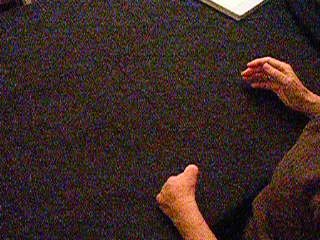
Streaming
video
(12.1 MB, 6’53) |
| Later in the
session, M.G. clarified that pulsing and pushing further
into her phantoms beyond the “ends” produces a more
intensive sensation
of “dih, dih, dih”, like a touching or tapping or a
kind of magnetic
resistance (the same poles of two magnets pulsing together), which is
felt in the finger buds. It
almost feels as if the phantom fingers are being pushed from their
normal place further up her arm.
Comparative
finger sensitivities over time:
- 7/25/07: Thumb=6, Index=6, Middle=4,
Ring=3, Pinky=4
- 9/10/07: Thumb=6, Index=6, Middle=5,
Ring=3, Pinky=3
- 9/11/07: Thumb=6, Index=2.5, Middle=4.5,
Ring=3, Pinky=2.5 (this session)
- Average: Thumb=6, Index=4.8, Middle=4.5,
Ring=3, Pinky=3.2 (N=3)
|
2007: Map of
phantom finger layout after “finding” them.
The phantom “ends”
generally appear to be longer than the physical fingers of the right
hand, by only a small amount (ring finger) to perhaps 2" (thumb). The
numbers by each
finger indicate the approximate apparent height of the
“finger” tips
above the
table at the time of measurement, ranging from 1/4" to 2".
In an earlier mapping there was also apparent curling up of the
fingers above the table, indicating that the procedure to find how long
the phantom finger are can be
problematic. A better procedure may be to measure the fingers with the
palm down.
|
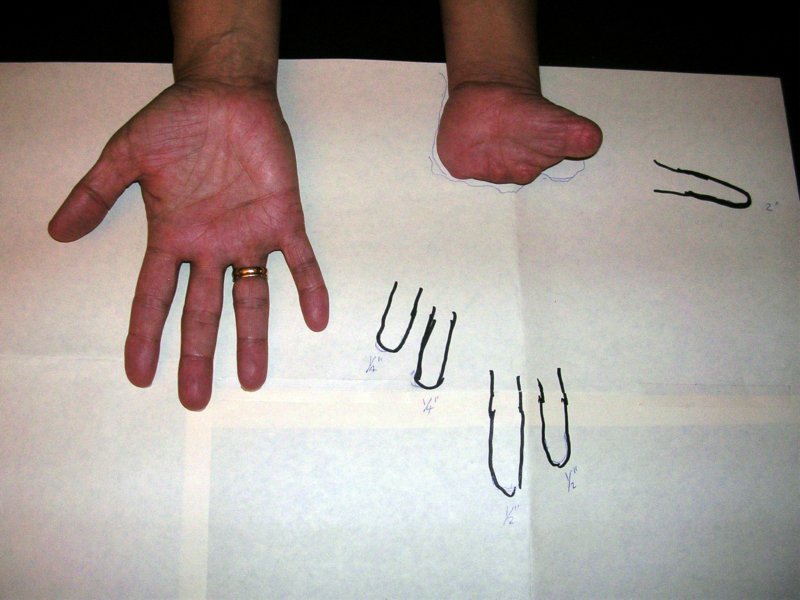
full
image |
| 2007: A
drawing of the apparent “field of sensation” around
M.G.’s physical
left hand,
showing the outer arc and the inner “ends” of
her phantom
fingers. In “finding” her phantoms, M.G. first
feels the
general outer
arc (a weaker sensation) but in that area there is a place where she
can feel something in the hand. This is the “stream”
of the phantom
finger, which M.G. can trace, following the sensation down to the
“end”
of the finger. The fingers are usually more diffuse and big, streaming
out when they are first “lit up”, and then by
interacting
with her
right fingers, they form up and become more defined. The fingers appear
to be able to bend and curl up toward the palm but M.G. has
never
felt the fingers bending “backwards”. M.G. can use
objects
like a table
to “activate” her fingers but the table interaction
feels
more vague if
the fingers are not activated first by her right hand. In any case, the
phantoms appear to become defined by interacting with something
“meeting” them. Otherwise they are
“streaming”,
or they are not sensed
at all because they have retracted or retreated (perhaps up the arm to
the upper arm) and need to be “lit up” or
“called
out”. |
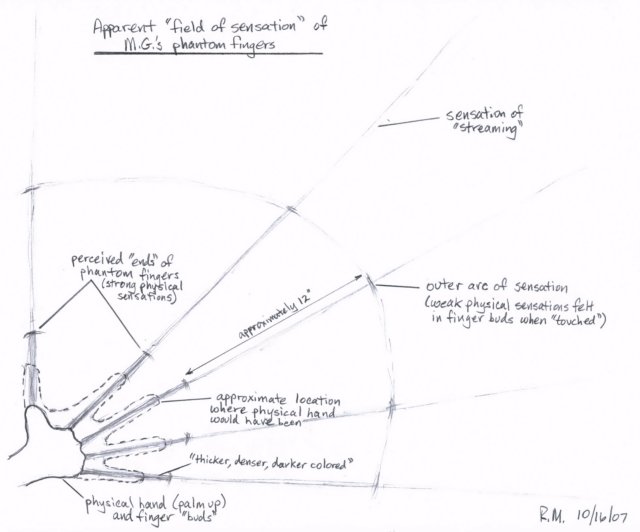
full image |
3.
Preliminary tests of M.G.’s sensations when
“touched” by an object (2007)
M.G. demonstrated that sensations were subjectively felt from
interactions with objects. She sensed a difference between
“touching” her fingers
by an object (a metal stapler) and the researcher’s hand.
With the
hand, the difference was clearly evident of a more solid,
“harder”, “thicker” feeling in
the palm of the
left hand, more like pressure, and
a strong pulling on the thumb finger bud. The object had a different
effect, making her finger bud twitch and felt less
“direct”
and more “remote”. At the end of the session, M.G.
reported
that her hand was
very
stimulated, perhaps overstimulated, with residual buzzing felt in the
physical hand between the index and the thumb finger buds.
4. Preliminary tests of
M.G.’s interactions with different areas of another
subject’s
face (2007)
M.G. touched a second subject (researcher S.M., age 59), touching eyes,
ears,
nose, lips (presumably the
tactilely
sensitive
areas of the face). A number of different sensations were reported by
S.M.
(shadows or
darkness, warmth, brightness, dark round disk with a white ring around
it). Latency was observed to be 3-4 seconds
generally but sometimes 10-15 seconds. The variability of responses and
the types of responses suggested to us that visual sensations probably
involved interactions with brain regions or the retina.
5.
Tests of M.G.’s interactions with different points on the
back of the
head (2007)
The
motivation for this
session was
to
test the idea that the sensations researcher S.M. was reporting were
due to
interactions with tactile nerves in the skin (warmth, pressure) and
with the brain (inner visual images). Therefore,
“touching” of the head
more directly in the brain regions might elicit more of the inner
visual images. This proved correct, particularly with point #9,
described in more detail below.
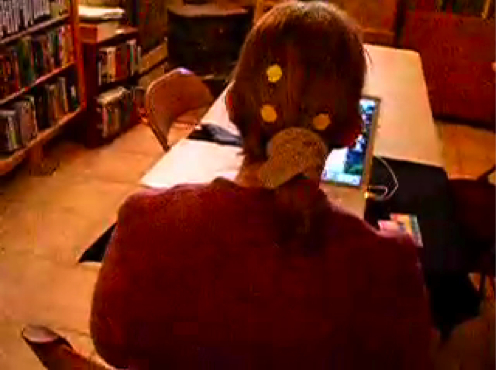
Streaming
video (2.2
MB, 1’46) |
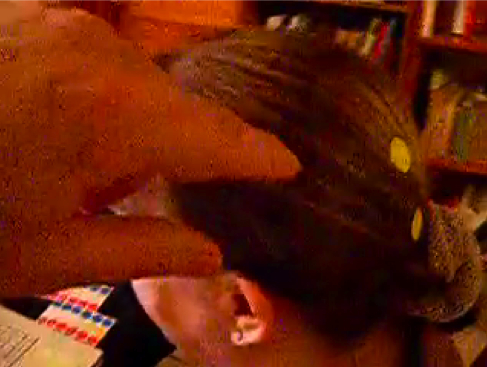
Streaming
video (3.8M,
1’49) |
M.G.
can also “touch”
another person and the “touch” is felt, especially
when the
other person’s head is “touched”.
Here,
a point in the right occipital/parietal area is
“touched” and a visual
image is perceived, similar to the images perceived with electrical
brain stimulation. The image
is perceived almost immediately when
M.G. moves her hand in closer (a “charge” going
right to left, a stream of light like a sword).
|
Another
area is “touched”. Note
the immediate reaction in subject S.M. when
M.G. moves her hand closer in: the shoulders raise and there is an
immediate response (perceiving a “beam” of dark
rich black, later superimposed with a black disc with a white rim or
corona around it)
|
A
total of 9 points were “touched” (two points on the
sides
are not shown). The images perceived were drawn and described in detail:
- Black
circles with a white ring, black swords with a white outline
(several instances each)
- Point
9 (blue) was a very strong
experience: a black
column rising through the body followed by a brilliant white
light filling the head, also felt physically in the body
and head.
“It’s dynamic, it has a movement, like I am moving
(upward)
through it, with a light streaming out. My whole head, my whole skull
is just white, just filled with light, with my whole skull feels like
it’s being energized, with a pulsing of the skull.”
|
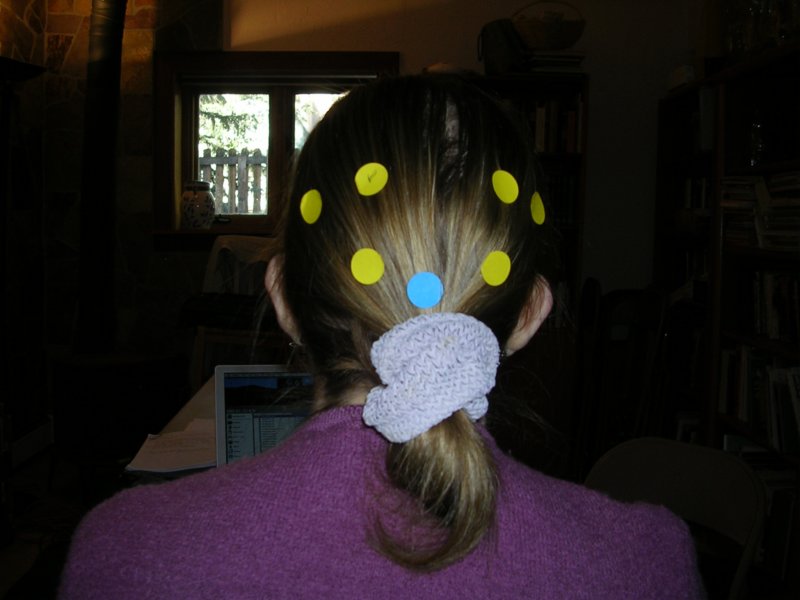
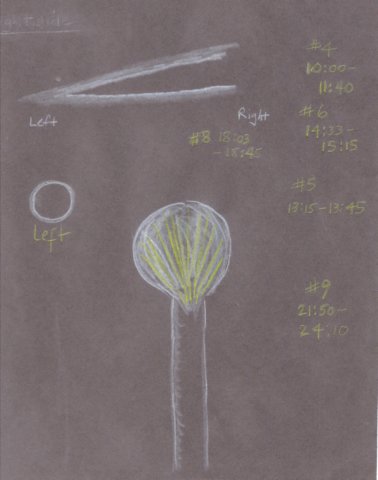
Point 9
reported sensations (streaming audio, 1.7 MB, 2'21)
Point 9
description (streaming audio, 6.1 MB, 8'20) |
6.
Tests of M.G.’s interactions with a different subject (2007)
We also
had M.G.
“touch” a different subject, researcher R.M., age
61. M.G.
“touched” four points on R.M.’s
head, similar to points 5, 6 and 9 for subject S.M. (shown below) and
also a point from the front, between the eyebrows. There
were only two visual sensations: a subtle white clouding of the visual
field with the eyes open, starting on the right visual field and moving
to the left field, when left rear point was
“touched”. When
the point
between the eyebrows was “touched”, with the eyes
closed,
R.M. perceived inwardly a single arc of color that
started from the bottom of the visual field and moved slowly up,
changing color as it moved up.
The drawing of the visual image when R.M. was touched between the
eyebrows.
There was a single arc of color moving from below upward, changing
color as it moved, until it disappeared at the top of the visual field. |
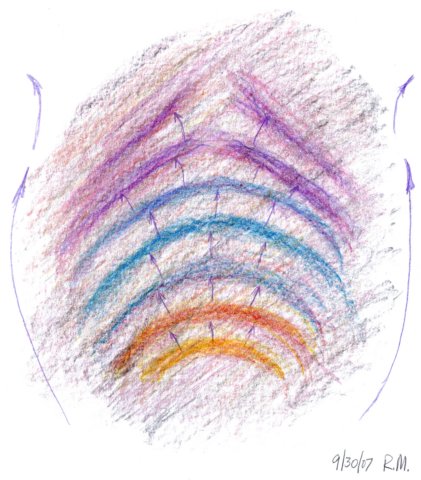
|
7.
Comparison of interactions with S.M. on the same
points, 2007 versus 2009
Subject S.M.’s responses when M.G.
“touched” the same points on
the back of the head in 2007 versus 2009 were somewhat similar (in two
cases S.M. gave very close to the same wording). However, the
points
in 2009 appeared weaker with fewer visual sensations. The points tested
both
years were:
 |
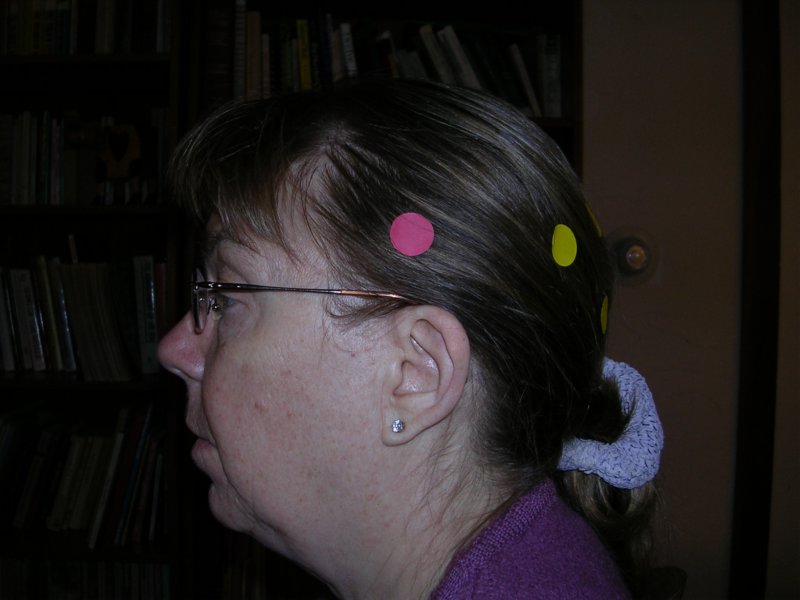 |
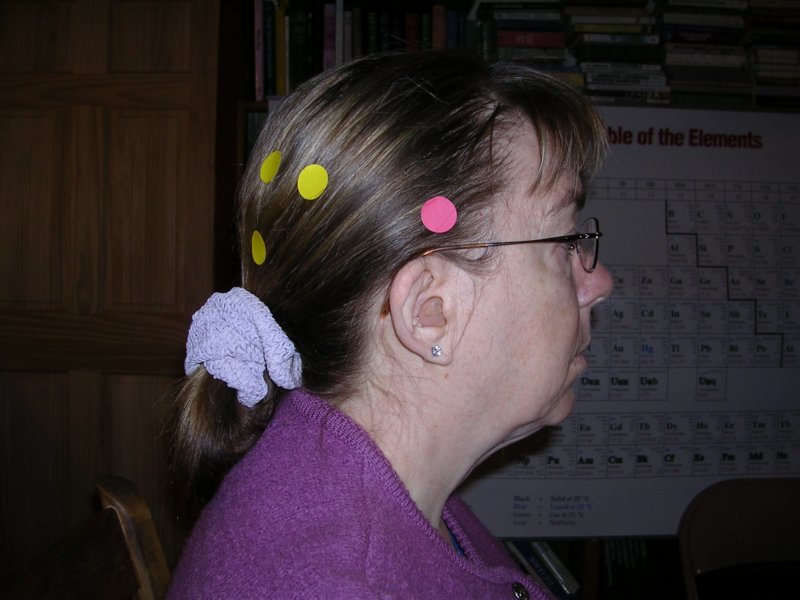 |
Top
row, left to right: 5, 2, 4, 6.
Bottom, L to R: 1, 9
(blue), 3. |
Red
point is #7 (approximately over left temporal lobe). Yellow
point is #5 |
Top
row, L to R: points #4 (yellow), #6 (yellow) and #8 (red, over right
temporal lobe). Bottom is #3 (yellow). |
In 2009, we tested all of the points on the first day and repeated
selected points on the second day. On the repeated points the
sensations were even weaker than the previous day, except for two
repetitions (points 6 and 9) which are worth including for further
comparison. The weaker sensations were probably due to
not having M.G. follow a fixed procedure to
“prepare” her phantom
fingers. Also as M.G. grew tired during a long session, her phantom
fingers appeared to weaken, both subjectively to M.G. and objectively
in the sensations reported by the other subject. On subsequent days, we
instituted a specific protocol for M.G. to follow to
“focus” her
fingers by drawing out all five fingers before she started working with
a subject. We also noted that the longer the stimulation, the stronger
the sensation that was experienced: the sensation built up
and
got stronger from 10 sec to 1 min.
| Pt |
2007
Description |
Repeat
8/4/2009 |
Comparison |
Repeat 8/5/2009 |
| 1 |
Activation
of the sinuses in
the
center of the face (eyes open) |
Pressure
in eyes and sinus areas |
Very
similar |
|
| 2 |
Energy
coming out of the top
center of head |
Top of
the head felt like a lid opening. Pressure, pleasant feeling |
Very
similar |
|
| 3 |
Activation
(energizing
feeling)
of sinuses behind both eyes, activation in center of head (charged
feeling) |
Jaws
tingling, pressure in eye sockets |
Somewhat
similar |
|
| 4 |
Warmth,
stream of light from right to
left:
like a dark sword shape with shimmering white outlining it (inner
visual image “added to” normal visual field) |
Pressure,
tingling in right eye socket and upper right part of the brain |
Dissimilar,
non-visual |
Pressure
top of head, light at end of a tunnel |
| 5 |
Beam of
dark black on left side of
visual
field, then black disk with white ring or corona around
it |
Left
eye, head expanding, opening |
Dissimilar,
non-visual |
|
| 6 |
Again
blade or sword of darkness with
white on the edges, going from right to left, stimulation of both eyes |
On the
right a white thin, vertical light, pressure on the right |
Somewhat
similar: both are visual, with white |
|
| 7 |
Strong
warmth radiating into the
head,
felt behind the ear (not on the spot “touched”) |
Left,
pain on top,
pressure from left to right through whole head. Top of head, mostly to
left, a kind of throbbing “nerve” pain, lingered
for some time
afterward. |
Dissimilar |
|
| 8 |
Warmth
in the area, again the dark
sword
with
white on the edges, a feeling of being charged in the area
“touched”
and a little to the left |
A tone
“trying” to sound. Prickling pain down right side
of neck. (Took relatively longer to feel any sensation.) |
Dissimilar,
much weaker, may have not touched same area |
|
| 9 |
Opening
of a
channel of
darkness in solar plexus (abdomen) with shimmering white light
surrounding it, like a column; the top of the channel (in the head) is
exploding light. It is like going up a tunnel with light at the top. |
Growing
pulsation,
pressure in the middle-top of head. Felt like a flowering stimulation,
vitalization of brain. Lingered for some minutes afterward. Very
pleasant feeling. |
Similar
but relatively weaker |
Pressure
in center/top of head to the heart - feeling of centeredness, opening
of the heart |
8. Different subjects also reported
complex visual experiences (2009)
Two out of six subjects
in addition to S.M. reported similar responses to
S.M.’s visual responses,
with striking and sometimes complex visual experiences. Visual
sensations occurred with the eyes open but were generally enhanced when
the subject’s eyes were closed.
Where we tried to repeat “touching” the same point
more than once, the
subject reported similar responses in each instance.
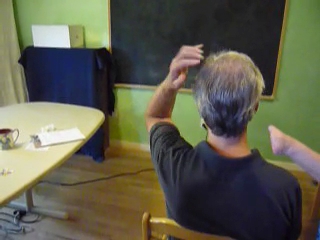
Subject A.G., age 56, visual impressions (eyes closed)
Streaming video (1.5 MB,
0’43) |
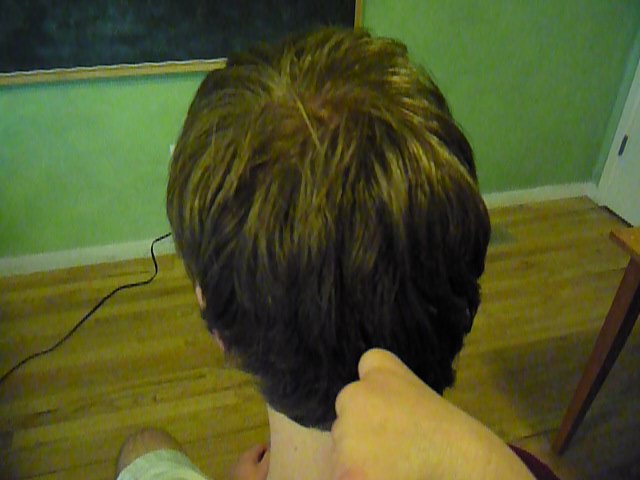
Subject F.S., age 18, visual impressions (eyes closed)
Streaming video (3.3 MB,
1’23) |
| A
fountain of white
light emanating out of the top of my skull and flowing down on a
diagonal to the bottom right; kind of like fireworks -- the middle of a
sparkler. When this point was repeated later, A.G. almost immediately
said: I have this curious image more from the bottom of my skull, light
streaming up like vertical search lights, and warmth/tingling over the
right side of my head and a lot of sunshiny color. (With eyes open, the
visual sensation was not as pronounced but returned when the eyes were
closed again.) |
(Subject
is speaking
very softly) Black surrounded by purple is flowing up like a lava lamp.
And I keep seeing these trees, biological tree shapes but in black
silhouette, moving from lower left to upper right and
turning into
just black bits. (This is just a small segment of a continuous stream
of visual sensations the subject reported. At the beginning of the
trial, with eyes open, the subject saw almost
immediately “some wavy things across my
vision” and somewhat later, diagonally falling heat waves.) |
9. Subjects had a wide range of
sensations and physical reactions (2009)
Different subjects
report different physical reactions, generally characteristic of the
subject, including strong sensations of warmth or a sensation of water
cascading over the head, a few cases of sharp, almost painful
sensations, a sense of the head being pushed to one side, the eyelid
twitching, the ear “popping”, and the stomach
“growling” as a response.
Frequently, strong sensations were reported lingering for several
minutes after the trial ended. The responses for different subjects
appear to have different
latencies of responding, ranging from about 4 seconds to sometimes
longer than 30 seconds. One subject
reported experiencing
a strong headache starting right after the session,
that appeared related to dizziness felt during the session. Subject
took ibuprofen and had a nap in the afternoon but still felt headachy
and went to bed early. Headache was resolved in the morning. It is not
entirely clear if the headache was causally
connected to the“touch” interaction, since subject had only
3-4 hours’ sleep the night before.
The following sequence (subject E.L., age 21) was taken from a trial
“touching” the back of the head with four
phantom fingers. There
was a noticeable increase in flushing of the cheeks, the side of the
neck below the ear, the upper back and the upper chest. After the
trial, the subject was
literally ruddy on the cheeks and upper chest. This condition lasted
several minutes after the trial.
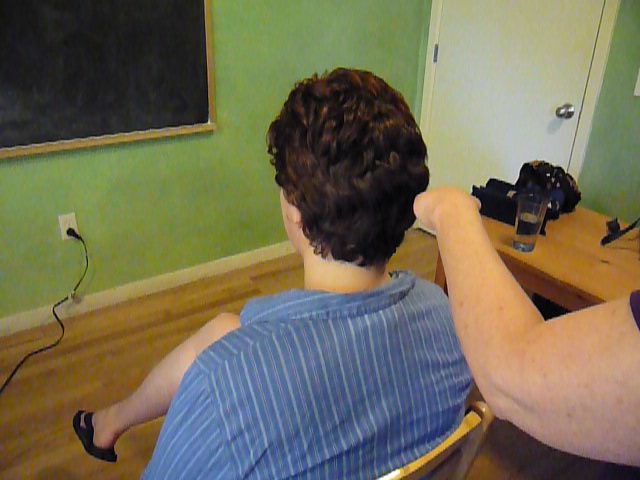 |
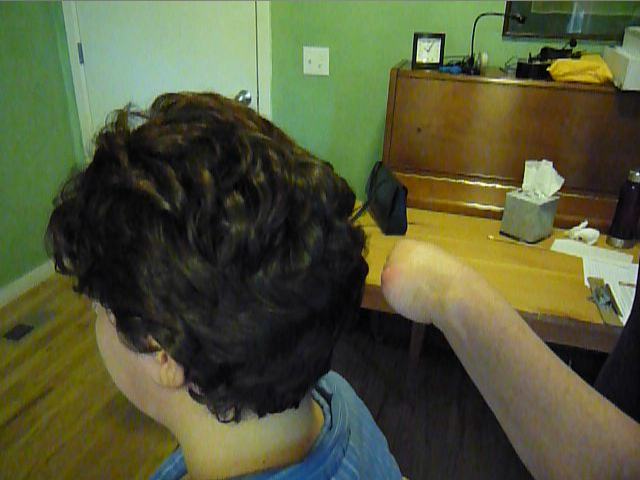 |
Trial at
0:06. Cheek starts out somewhat flushed.
|
Trial at
2:19. Sensation felt in forehead
|
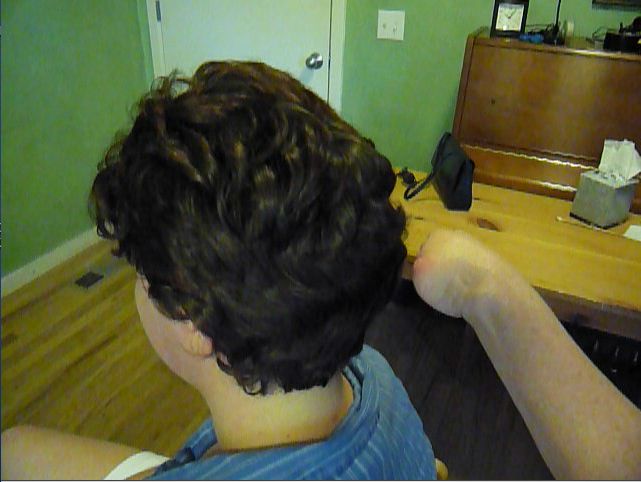 |
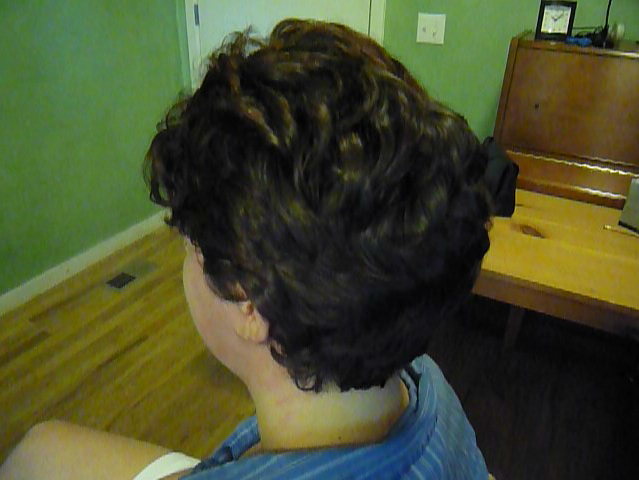 |
| Trial at
3:01. First mention of sensation of warmth. Additional flushing first
noticed. |
Trial
ended at 4:47. Deep flushing noted on cheeks, side of neck and the nape. |
- 0:00 Start, eyes are open. Cheeks start
out somewhat flushed.
- 0:48 Scalp on top of head is tingling.
Subject instructed to close eyes.
- 1:51 Sensation felt inside the forehead.
- 2:40 Sensation inside forehead is a
“feathery feeling like when I am on the verge of
sleep”.
- 3:00 Warmth, too. (First mention of
warmth.)
- 3:10 Warmth is getting stronger.
(Flushing along the side of the neck first noted.)
- 3:45 Warmth is cascading from the top
of head down to the cheeks.
- 3:55 Warmth is going down further.
- 4:20 Cascading feeling of warmth is
mostly in the front and on the sides.
- 4:40 It’s a pleasant feeling,
but it’s very hot now. (Cheeks are very flushed.)
10. Preliminary blinded trials of
randomized “touch” and “no
touch” cases (2009)
We tried two preliminary
single blinded trials of randomized “touch” and
“no touch” cases, providing
immediate feedback to the subject (n=7 and n=6). The two subjects got
nearly perfect scores detecting a phantom finger touch versus a control
(a leather mitten held on a yard stick). The subjects’
perceived
strength of sensation also corresponded well with M.G.’s
perceptions of
the strength of the “touch”. In both of these
cases, the strength of
the sensations was generally weak to strong. The sensations were not
visual but rather a tingling or pressure or a sense of the head being
rotated.
For subject D.S., age 17, we selected a previous point (#5) at the back
of the head, eyes open, that produced a “very
strong” sensation of the
head being pushed to the right. M.G. used a sequence of randomly
generated 1’s and 0’s to determine whether to
“touch” or use the
control. The timing of each step of the trials was kept constant and
M.G.’s movements were also equivalent between “touch”
and “no touch”
trials. The thumb of the leather glove and M.G.’s thumb bud
were kept
at approximately the same distance from the back of the
subject’s head.
D.S. was told after each trial whether the trial had been
“touch” or “no touch”.
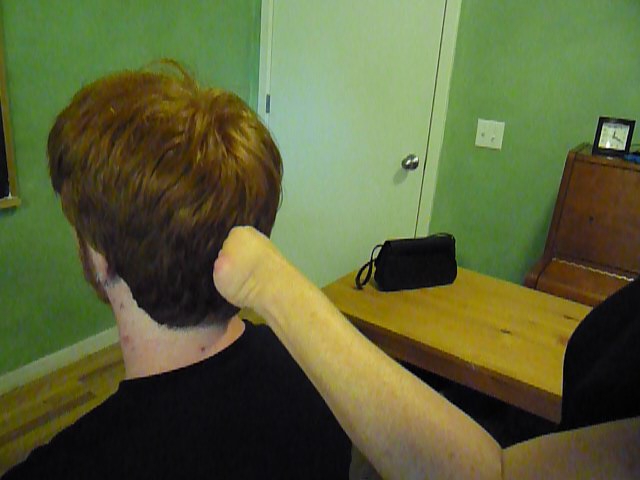 |
 |
| Subject
D.S. “touch” trial |
Subject
D.S. “no touch” trial |
| Trial |
D.S. reported strength |
D.S. comments |
M.G.comments |
Correct? |
| “Touch” |
5 |
Back
left of head: feeling of pushing/ROTATION to the right and slightly
down, dizziness on left if attempt to counter the feeling of rotation |
|
Yes |
| “No
touch” |
0 |
|
|
Yes |
| “Touch” |
3 |
Sense
of head being rotated to the right, a little fainter than previous. |
|
Yes |
| “Touch” |
2 |
Ditto,
weaker still than the previous |
weaker
for me |
Yes |
| “No
touch” |
0 |
|
|
Yes |
| “Touch” |
1 |
Very faint
feeling of pushing to the right. |
--
weak -- |
No, but
correlated |
The reported strength is on a scale of 0 to 5: 0=None, 1=Faint, 2=Weak,
3=Moderate, 4=Strong, 5=Very strong. In scoring whether a sensation was
correct, we used the criteria that a strength of 0 - 1 is a
“no touch”
and >1 is a “touch”. The last
trial thus was not correct.
However, note that the “touch” was perceived by
both subjects as very
faint or weak and that the reported strength of the
“touch” trials
progressively declined. This series of trials was done at the end of
the second hour-long session of the morning and M.G. reported that she
was
getting tired. The subjects took a break between trials 4 and 5.
This preliminary experiment was done informally, so no conclusion can
be drawn. In the future, experiments of this sort need to be
double blind, with stricter controls to eliminate other perceptual cues
such as peripheral sight and hearing. Further work needs to be done to
validate a proper control for
the “no touch” case, such as the glove held at a
distance, that does
not result in false positives.
11.
M.G.’s own sensations and physical reactions during the tests
(2009)
M.G. had numerous
reactions and sensations while “touching” other
subjects,
including a
strong sense of warmth or light when working on what she felt were
“strong” points on the other subject and twice
heard a tone
(middle C,
d’) with an electrical hum quality. M.G. noted many times
that what
the other subject reported corresponded or correlated to her own
specific experiences. In some cases, M.G. felt that she had
“touched”
and “felt” the other person’s brain
within their skull. We
also noted
that M.G. frequently had nasal congestion after a subjectively felt
“strong” “touch”
trial and had to blow her nose.
12.
Tests of possible physical interactions with M.G.’s phantom
fingers (2009)
We have tested possible physical interactions three ways so far, all
with negative results:
- In
2008, we conducted an experiment to see if there was any interaction of the phantom
fingers with fog
generated from dry ice and warm water. This experiment was motivated by
the story of an NDE involving apparent interaction of the
NDEr’s “body”
with fog
on a cold night. The NDEr jumped up and down and the “jumping
fog” was
seen by another man. M.G.
activated her phantom fingers as usual and placed her
hand in the dry ice vapor. There was no effect at all. The situation in
the
NDE was somewhat different in that the NDEr’s
“movements” were
involved
and M.G. is not able to move her phantom fingers, which are
subjectively frozen in
position.
- We
tested interaction
with light
in an interferometer.There was no perceptible change in
the
interference pattern when M.G. placed her phantom thumb within the
laser light of either leg of the interferometer or when
she “touched” the
laser spot on the splitting mirror.
- Interaction with a physical object:
We arranged an interferometer with one of the mirrors suspended from
two threads such that any slight movement would cause the laser light
to go out of phase. We noted that even “at rest” there was an
oscillation of the interference pattern in and out of phase, probably
due to random vibrations of the mirror. There was
also no perceptible change in the
interference pattern when M.G. “pushed” her thumb
and other
fingers
against the mirror, that is, the oscillations in and out of phase did
not measurably change.
Conclusion: To
the
level of precision and care that we were able to accomplish with this
apparatus, we detected no effect of interaction of the phantom finger
regions with laser light or with a physical object. It is very possible
that measurable effects could be detected with more precise equipment
or a better constructed arrangement.
Access
to detailed research results
For privacy considerations for M.G.and the other subjects, we wish to provide access to
the more extensive, detailed experimental results only to those people with a
legitimate research interest. If
you are in this category, please contact
us for access details. We also welcome your comments and can
provide further details upon request.
|